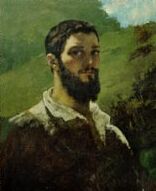Gustave Courbet
Gustave Courbet (b. 1819 Ornans, France - d. 1877 La Tour-de-Peilz, Switzerland), French Realistic painter. He was also an enthusiastic sportsman.
In 1839 Courbet moved to Paris and copied older art at the Louvre (Caravaggio). His work was also influenced by the art of Rembrandt and Frans Hals. He painted portraits, still lifes, landscapes, seascapes, female nudes and contemporary social issues. In his works he attempts to represent persons and scenes as they really appear. Courbet coined the term Realism to define his interest in the actual circumstances of his day.
Gustave Courbet had a great influence on impressionist painters like Renoir.
| “ |
Fine art is knowledge made visible. |
” |
In the 19th century landscape painting gained a new supremacy due to the artworks of painters of the Barbizon School such as Theodore Rousseau and Charles Daubigny, or the Revolutionary artist Gustave Courbet, who pushed the boundaries of landscape painting even further, and the Impressionists whom devoted most of their careers to studying and painting the landscape; The influence of Courbet extended well beyond Impressionism, impacting the work of Paul Cézanne and Vincent Van Gogh, as well as painters in the 20th century. [1]
In 1872 he moved to Switzerland where he died in 1877 after painting the rough Swiss terrain.
See also
- Claude Monet
- Edouard Manet
- Painting Schools
- Painting Masterpieces
- French Lanscape Painting
- French Still Life Painting
External links
- Biography
- Artist Biography
- Musée Courbet In French.
Château d’Ornans






